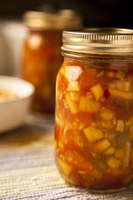Preserve Your Garden’s Bounty Safely
(Click the image below to view a high-resolution image that can be downloaded)
Your garden is producing way more vegetables than you can eat now, so you’ve decided to can some to use later.
You‘ve found lots of recipes on the Web and in old cookbooks, and friends and family have offered you tons of advice on how to preserve those vegetables.
“The trouble is that most of those recipes haven’t been tested for safety,” says Julie Garden-Robinson, North Dakota State University Extension Service food and nutrition specialist.
Plus, food preservation guidelines have changed through time. So, should vegetables, meats and most mixtures of foods be canned only in a pressure canner? If you came upon a recipe that suggests canning food in your oven, would it be safe?
The answer is “yes” to the first question and “no” to the second question, according to Garden-Robinson.
“The acidity of a food determines how it should be canned,” she says. “Low-acid foods such as meat, poultry, seafood, soups, vegetables (except those that have been acidified) and mixtures of acidic and low-acid foods must be processed in a pressure canner.”
Canning in an oven is not safe, she adds. It can be extremely dangerous for low-acid foods.
Using up-to-date equipment and research-tested methods when preserving food is vital. Improper heat processing of home-canned food can lead to the growth of bacteria and production of toxins that may cause botulism, a potentially deadly form of food poisoning.
Listeria is another type of bacteria sometimes associated with home-preserved food. It grows at refrigerator temperatures and can survive in acidic conditions.
“Listeria could survive and grow in unprocessed refrigerator pickles without the proper level of vinegar,” Garden-Robinson says. “Many molds, yeasts and some bacteria survive in acidic environments. The best way to inactivate them is to process pickles in a water-bath canner for the recommended time.”
What if you invent your own salsa recipe? Is it safe to can as long as you process it in a water-bath canner? That’s not a good idea, health experts say. The best way to preserve salsa made from a recipe that hasn’t been research-tested is freezing it.
And if you are using a research-based recipe, follow it carefully. Substituting ingredients and changing proportions can be a recipe for disaster.
Tomatoes are one vegetable needing a little extra attention when canning them. They vary in the amount of acid they contain, depending on the variety and growing season. That means they should be acidified with lemon juice or citric acid before they are canned in a water-bath or pressure canner. Add 1 tablespoon of bottled lemon juice per pint of tomatoes, or 2 tablespoons of bottled lemon juice per quart.
Most vegetables should be blanched before being frozen. Blanching is scalding vegetables in steam or boiling water for a short time. That keeps vegetables from discoloring, toughening or developing off-colors or off-flavors during frozen storage.
Now that you’re ready to can or freeze some of your garden’s bounty, you need to decide what kind of containers to use.
“You can use glass mayonnaise jars to can acidic foods such as fruit sauces in a water-bath canner, but Mason-type jars are the best choice for canning,” Garden-Robinson says. “Mayo jars have a narrower sealing surface and are tempered less than Mason jars, so expect more seal failures and breakage when reusing jars that once held commercial products. Don’t process mayo jars in a pressure canner.”
To seal jars, use self-sealing lids that consist of a flat lid and a screw band. Tighten the screw band with your fingers, not your muscles, because overtightening can lead to seal failures. You can reuse screw bands, but don’t reuse lids.
When freezing vegetables, use plastic freezer containers, glass canning or freezing jars and plastic bags designed for freezer storage. Using plastic containers that previously held products such as margarine or whipped topping can result in the food developing freezer burn or dehydrating.
“Freezer burn is a quality issue, not a safety issue, but you may not want to eat freezer-burned food because of the changes in the color, texture and flavor,” Garden-Robinson says.
Prepare for food preservation by finding research-based recipes and being sure you have all the equipment and supplies you’ll need. For more information about food preservation, visit the NDSU Extension Service’s website at http://www.ag.ndsu.edu/food.
NDSU Agriculture Communication
| Source: | Julie Garden-Robinson, (701) 231-7187, julie.garden-robinson@ndsu.edu |
|---|---|
| Editor: | Ellen Crawford, (701) 231-5391, ellen.crawford@.ndsu.edu |


